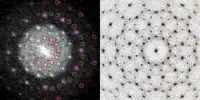Heating accounts for around 50 percent of global final energy use. However, solar power use in this sector remains low when compared to fossil energy sources. The intermittent availability of solar energy is a fundamental issue that limits its broad use. Molecular solar energy storage technologies appear to be a promising answer.
According to the International Energy Agency, heating accounts for around 50 percent of global final energy use. However, solar power use in this sector remains low when compared to fossil energy sources. The intermittent availability of solar energy is a fundamental issue that limits its broad use. Molecular solar energy storage technologies appear to be a promising answer.
Conventional thermal energy storage solutions, such as hot water, store energy for a brief period of time. In contrast, molecular solar energy storage systems store solar energy in the form of chemical bonds, allowing it to be kept for weeks or even months. These specialized molecules, known as photoswitches, absorb solar energy and then release it as heat on demand.
However, a significant difficulty for contemporary photoswitches is the trade-off between energy storage capacity and efficient absorption of solar light, which limits total performance. To address this issue, researchers from Johannes Gutenberg University Mainz (JGU) and the University of Siegen present an innovative technique in a collaborative study.
Heating accounts for around 50 percent of global final energy use. However, solar power use in this sector remains low when compared to fossil energy sources. The intermittent availability of solar energy is a fundamental issue that limits its broad use.
Decoupling the absorption and storing processes of solar energy
Professor Heiko Ihmels’ group at the University of Siegen was the first to introduce this innovative class of photoswitches, which demonstrated excellent energy storage potential similar to conventional lithium-ion batteries. However, their effectiveness was initially confined to activation by UV light, which makes up only a small portion of the solar spectrum.
The researchers at Mainz and Siegen have now developed an indirect light harvesting approach similar to the function of the light-harvesting complex in photosynthesis. This incorporates a second molecule, known as a sensitizer, which has outstanding visible light absorption capabilities. “In this approach, the sensitizer absorbs light and then transfers energy to the photoswitch, which cannot be directly excited under these conditions,” noted Professor Christoph Kerzig from the JGU Department of Chemistry.
This new strategy has increased solar energy storage efficiency by more than one order of magnitude, representing a major step forward for the energy conversion research community. The potential applications of these systems span from household heating solutions to large-scale energy storage, offering a promising path towards sustainable energy management.

Mechanistic studies essential for reaction discovery and optimization
The Mainz-based team of researchers led by Professor Christoph Kerzig and PhD student Till Zähringer conducted detailed spectroscopic analyses to explore the complex system, which were essential for understanding the underlying mechanism. Each reaction step was carefully examined by the paper’s first author, Till Zähringer, resulting in a thorough understanding of how the system operates.
“By doing so, we could not only push the light-harvesting limit substantially but also improve the conversion efficiency of light to stored chemical energy,” Zähringer told me. Under operational conditions, each absorbed photon can initiate a chemical bond formation process, which is unusual in photochemical processes due to multiple energy loss routes. The scientists successfully confirmed the system’s durability and practicality by cycling between the energy storage and release states several times using solar light, demonstrating its potential for real-world applications.
The findings were reported in Angewandte Chemie, where the work was designated as a Hot Paper due to outstanding ratings by scientific reviewers.
















